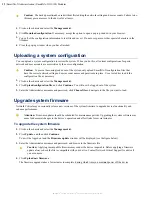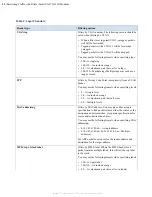
42
| Configuring Ports | SmartNA-X 1G/10G Modular
SmartNA-X
™
1G/10G User Guide 1.4
©
2015 Network Critical Solutions Limited
Chapter
4
Configuring Ports
Configuring Ports
The SmartNA-X chassis can house up to four independently operating modules. Each module contains four ports (
A–D
),
which operate in pairs (
AB
and
CD
). At the rear of the chassis are two 10G ports (
R0
and
R1
). All ports support full-rate
data throughput at the advertised rate, and can be mapped to any other port regardless of any differing physical properties.
Working with copper ports
When working with copper ports, you may need to configure port settings in order to establish an efficient connection
with the link partner.
In most cases, you can leave the port set to auto-negotiation, whereby the ports themselves determine the optimum
connection properties. To safeguard a TAP against device failures, you can enable port failsafe by turning on TAP mode.
About auto-negotiation
Auto-negotiation automatically determines optimum settings for port speed, duplex and mastery, but not MDI. Under
normal operations you can leave auto-negotiation enabled.
Copper ports can operate with auto-negotiation ON or OFF. This setting is controlled by the Auto-Negotiation option in
the web UI, or by the
set port autoneg
command in the CLI. Under normal operations, you should leave auto-negotiation
ON. If you set auto-negotiation to OFF the port will be limited to 100M bps.
Auto-negotiation set to OFF
The following details should be noted when auto-negotiation is set to OFF:
• Port duplex setting must be either full-duplex or half-duplex (not "auto"), and must match the link partner setting.
• Port speed setting must be either 10M or 100M (not 1G or "auto"), and must match the link partner setting.
• Port mastery setting is irrelevant.
If auto-negotiation is OFF the speed and duplex settings must match those of the link partner. If the partner port is set to
auto-negotiation, the partner port will attempt to connect in half-duplex mode, leading to a mismatch if the SmartNA-
X port is set to full-duplex. Therefore, it is best to set auto-negotiation OFF on the partner port when auto-negotiation is
turned off.
Auto-negotiation set to ON
Normally, you should set port speed to "auto" and duplex to "auto". However, it is possible to restrict the capability
advertisement during auto-negotiation to a single speed setting and/or a single duplex setting by setting speed to 10M,
100M or 1G, and/or duplex to half- or full-. For example, if duplex is set to full and speed to 100M the port will only
connect at 100M full duplex.
About MDI
Port MDI setting controls the MDI/MDI-X cable crossover mode for a copper port.
Selecting auto enables the port to automatically set MDI crossover correctly. If you prefer to use a fixed MDI setting (that
is, not auto), you must ensure the link partner is set to the
opposite
MDI/MDI-X setting or is using auto.
If using the same settings on both ends, you must use an Ethernet crossover cable to ensure the transmit and receive
signals are matched at the connector level.






























